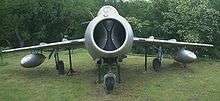Ram-air intake

A ram-air intake is any intake design which uses the dynamic air pressure created by vehicle motion to increase the static air pressure inside of the intake manifold on an internal combustion engine, thus allowing a greater massflow through the engine and hence increasing engine power.[1]
Design features

The ram-air intake works by reducing the intake air velocity by increasing the cross-sectional area of the intake ducting. When gas velocity goes down the dynamic pressure is reduced, while the static pressure is increased. The increased static pressure in the plenum chamber has a positive effect on engine power, both because of the pressure itself and the increased air density that this higher pressure gives.
Ram-air systems are used on high-performance vehicles, most often on motorcycles and performance cars. The 1990 Kawasaki Ninja ZX-11 C1 model used a ram-air intake the very first on any production motorcycle.[2] [3]Ram-air was a feature on some cars in the sixties, falling out of favor in the seventies, but recently making a comeback. While ram-air may increase the volumetric efficiency of an engine, they can be difficult to combine with carburetors, which rely on a venturi-engineered pressure drop to draw fuel through the main jet. As the pressurised ram-air may kill this venturi effect, the carburetor will need to be designed to take this into account; or the engine may need fuel-injection.
Modern parachutes and kites use a ram-air system to pressurize a series of cells to provide the aerofoil shape.
At low speeds (subsonic speeds) increases in static pressure are however limited to a few percent. Given that the air velocity is reduced to zero without losses the pressure increase can be calculated accordingly. The lack of losses also means without heating the air. Thus a ram-air intake also is a cold air intake. In some cars the intake is placed behind the radiator, where not only the air is hot, but the pressure is below ambient pressure. The ram-air intake effect may be small, but so are other mild tuning techniques to increase cylinder filling like using larger, fresh air filters, high flow mass flow sensors, velocity stacks, tuned air box and large tubes from the filter to the engine.
Aircraft
Pitot sensors are used to measure ram pressure, which is added to static pressure to derive the airspeed of an aircraft.
 TA-4SU Super Skyhawk, note the ram-air intake mounted on the portside air intake for cooling the jet engine.
TA-4SU Super Skyhawk, note the ram-air intake mounted on the portside air intake for cooling the jet engine. Mikoyan-Gurevich MiG-15
Mikoyan-Gurevich MiG-15 Diagram of piston engine with (from left to right): 1.) Ram-air intake, 2.) Air filter, 3.) mass flow sensor, 4.) butterfly valve, 5.) air box, 6.) intake runners, 7.) intake valve, 8.) piston, 9.) exhaust valve, 10.) extractor pipe, 11.) collector, 12.) catalytic converter, 13.) muffler.
Diagram of piston engine with (from left to right): 1.) Ram-air intake, 2.) Air filter, 3.) mass flow sensor, 4.) butterfly valve, 5.) air box, 6.) intake runners, 7.) intake valve, 8.) piston, 9.) exhaust valve, 10.) extractor pipe, 11.) collector, 12.) catalytic converter, 13.) muffler.
See also
- Air filter
- Booster
- Ramjet
- Supercharger
- Turbocharger
- Warm air intake
- Short ram air intake
- Diffuser (automotive)
References
- ↑ Cabello, Cabello; Baz, Pablo (2015-06-13). "Sistema aerodinámico Ram-Air: funcionamiento" [Aerodynamic system ram-air: operating mode]. Motociclismo (in Spanish). Retrieved 2016-08-20.
- ↑ Burns, John (December 24, 2013). "30 Years of Ninjas: 1984 GPz900 Ninja to 1990 ZX-11!". Cycle World. Retrieved December 2, 2016.
- ↑ "Ram Air: Test". Sport Rider. October 1999. Retrieved December 2, 2016.